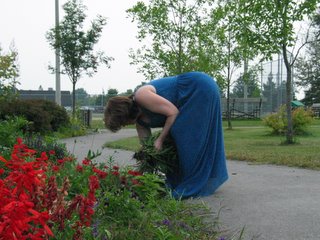Creative Xeriscaping in the Osgoode Public Garden
The City of Albuquerque website says it perfectly: "The term xeriscape is derived from the Greek word xeros meaning dry, combined with landscaping, thus xeriscaping. The term was coined by the Front Range Xeriscape Task Force of the Denver Water Department in 1981. The goal of a xeriscape is to create a visually attractive landscape that uses plants selected for their water efficiency. Properly maintained, a xeriscape can easily use less than one-half the water of a traditional landscape. Once established, a xeriscape should require less maintenance than turf landscape."

The Osgoode Public Garden is never watered! With the hundreds of plants that grow there, only a handful of plants have not survived - and it was because of too much water in the spring causing root rot! There are three key ingredients which make our garden so durable throughout a demanding growing season.
1. the soil is rich and absorbent ("Tripple Mix" from Greely Sand and Gravel)
2. there is excellent drainage because these gardens are built on top of Osgoode sand (we do not "ammend" Osgoode sandy soil. Rather the tripple mix is just dumped on top of the existing soil)
3. we can grow MORE than xeriscape plants because we mulch heavily in all the right places

By using the above combination of strategies, the Osgoode Public Garden is xeriscaped but it doesn't LOOK like your typical xeriscape (rock garden/desert-scape). The mulch and absorbent soil allow other plants to mingle with drought tolerant plants. For example, roses (Explorer Series) sit beside iris or flax. Iris and some other plants are mulched very lightly or they will rot. Peonies mix with sedums. Blue oat grss and cosmos nestle near hostas. The design possibilities are endless. Plant companions are chosen to accentuate opposite foliage shapes and colours, ensure bloom is ever present, and alternate heights to dramatic effect. Some tall plants are planted in front of lower plants as a "peekaboo" style, which adds intrigue.
Xeriscaping does not mean that plants can grow in crappy soil without water. The plants that are tough, actually enjoy good soil and are only tolerant of crappy soil if they have to be. Therefore, we plant all plants in the tripple mix and we have amazing results!
 Most of our gardens are high berms because the soil is so sandy that the gardens are built with tripple mix mounded on top of the existing soil. The berms also give the appearance of height in an otherwise flat park landscape. Berms are tricky to design with plants because of these factors:
Most of our gardens are high berms because the soil is so sandy that the gardens are built with tripple mix mounded on top of the existing soil. The berms also give the appearance of height in an otherwise flat park landscape. Berms are tricky to design with plants because of these factors:1. south-western facing slopes of the berm are hotter and drier than flat gardens
2. north-eastern slopes of berms are shadier and drier than flat gardens
3. wind can be harsher on a berm than in a flat garden
We use "obstacles" on the berms to slow down water runnoff. Rocks of all sizes are used as natural retaining walls and not only do they block runnoff but they maintain an even moisture underneath them. This is why thyme likes rocks so much. The thyme is not actually a good xeriscape plant unless it has rocks to shelter the roots. For this reason, thyme lawns don't work but rock gardens planted entirely of thyme DO work!
For the hot dry slopes, verbenas and salvias and celosias all do well. For the semi-shaded, dry sides of slopes, turtlehead, junipers and grasses are happy.
Ground covers are helpful and are grown around the bases of other taller plants. We tend to plant really tough annuals and perrenials on the tops of the berms since we like tall plants to extend the height as much as possible! Examples would be Willow 'Hakuro-nishiki', Baptisia, Miscanthus Sinensis 'Purpurescens', Cosmos, Verbena Bonariensis. Near the bottoms of the berms, roses, box and hostas or crambe can grow because of mulch and the fact that they are receiving the rain runnoff from the top of the berm. This is called a "rain garden".
Wood Chip Mulch is laid on the gardens once every year to a depth of 3 inches. No irrigation is used. In the spring, we rely on adequate rain fall to sustain seedlings until they become established. One year was very very dry and the dryness continued throughout the summer. I believe the City of Ottawa watered the trees in the garden using water trucks once but that was a rare occaision. Rocks are not used much for mulch as the temperature around rocks is higher due to absorbtion of the sun and can stress out many plants.
Some small "standard" or "lolipop" trees and shrubs are pruned so that plants can enjoy a part-sun environment underneath them. During drought, many plants survive better in part sun instead of full sun because the soil does not dry out so much.
All of the plants in the Osgoode Public Garden are chosen for excellent drought/winter durability, high number of blooms over a long period, desease resistance, unique foliage and "latest and greatest appeal". Brand new hybrids purchased from private nursuries or nursuries specializing in unusual specimens are planted every year.
For more information on Xeriscaping: http://www.cabq.gov/waterconservation/xeric.html , http://www.ext.colostate.edu/pubs/garden/07228.html



